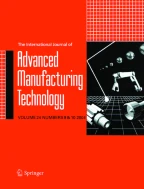Abstract
In the cold rolling process, automatic surface defect detection could be considered as an important technique to monitor product quality, and so far, substantial kinds of surface defects have been already successfully inspected. However, the interference of industrial liquids and produced surface textures has been rarely studied yet. To address this problem, the vision-based automatic detection method is proposed in this paper containing three main parts: (i) region extraction, (ii) defect detection, and (iii) industrial liquid quantification. Four sets of experiments are designed to verify the feasibility, accuracy, and stability of the proposed method. The results indicate that the proposed method can detect most cracks and scratches with the accuracy of more than 91 %. Also, the proposed method could accurately quantify the industrial liquids including their numbers (with the average accuracy of more than 90 %) and their sizes (with the accuracy of more than 91 %); it is therefore expected to be promising because it could be utilized to track the online running status of the rolling system and provide rolling system maintenance suggestions.
Similar content being viewed by others
References
Rajput R (2007) A textbook of manufacturing technology: manufacturing processes. Firewall Media
Lambiase F (2013) Optimization of shape rolling sequences by integrated artificial intelligent techniques. Int J Adv Manuf Technol 68(1–4):443–452
Roberts WL (1978) Cold rolling of steel. Dekker
Bruzzone AAG, Costa HL, Lonardo PM, Lucca DA (2008) Advances in engineered surfaces for functional performance. CIRP Ann Manuf Technol 57(2):750–769
Yun JP, Choi SH, Seo B, Park CH, Kim SW (2008) Defects detection of billet surface using optimized gabor filters. In: Proceedings of the 17th world congress international federation of automatic control Seoul, pp 77–82
Li X, Tso SK, Guan XP, Huang Q (2006) Improving automatic detection of defects in castings by applying wavelet technique. IEEE Trans Ind Electron 53(6):1927–1934
Sylla C (2002) Experimental investigation of human and machine-vision arrangements in inspection tasks. Control Eng Pract 10(3):347–361
Suresh BR, Fundakowski RA, Levitt TS, Overland JE (1983) A real-time automated visual inspection system for hot steel slabs. IEEE Trans Pattern Anal Mach Intell 5(6):563–572
Maki H, Tsunozaki Y, Matsufuji Y (1993) Magnetic on-line defect inspection system for strip steel. Iron Steel Eng (USA) 70(1):56–59
Strom Y (1992) Automatic surface inspection of continuously cast billets. Iron Steel Eng (USA) 69(5):29–33
Rao BPC, Raj B, Jayakumar T, Kalyanasumdaram P (2002) An artificial neural network for eddy current testing of austenitic stainless steel welds. NDT & E Int 35(6):393–398
Gong R, Chu M, Wang A, Yang Y (2015) A fast detection method for region of defect on strip steel surface. ISIJ Int 55(1):207–212
Jia H, Murphey YL, Shi J, Chang TS (2004) An intelligent real-time vision system for surface defect detection. In: Proceedings of the 17th International Conference on Pattern Recognition, pp 1051–1055
Tolba A, Raafat HM (2015) Multiscale image quality measures for defect detection in thin films. Int J Adv Manuf Technol 79(1–4):113–122
Landstrom A, Thurley MJ (2012) Morphology-based crack detection for steel slabs. IEEE J Sel Top Sign Process 6(7):866–875
Medina R, Gayubo F, González-Rodrigo LM, Olmedo D, Bermejo J, Zalama E, Peran JR (2011) Automated visual classification of frequent defects in flat steel coils. Int J Adv Manuf Technol 57(9–12):1087–1097
Ginzburg VB (2009) Flat-rolled steel processes: advanced technologies. CRC Press
Achanta R, Shaji A, Smith K, Lucchi A, Fua P, Su¨sstrunk S (2012) SLIC superpixels compared to state-of-the-art superpixel methods. IEEE Trans Pattern Anal Mach Intell 34(11):2274–2281
Gonzalez RC, Woods RE (2002) Digital image processing. Prentice Hall, Upper Saddle River, NJ
Yang C, Zhang L, Lu H, Ruan X, Yang MH (2013) Saliency detection via graph-based manifold ranking. IEEE conference on computer vision and. Pattern Recogn:3166–3173
Oskoei MA, Hu H (2010) A survey on edge detection methods. University of Essex, UK
Mak KL, Peng P, Yiu K (2009) Fabric defect detection using morphological filters. Image Vis Comput 27(10):1585–1592
Degarmo EP, Black JT, Kohser RA (2003) Materials and Processes in Manufacturing (9th ed.). Wiley
Arce GR (2005) Nonlinear signal processing: a statistical approach. John Wiley & Sons
Pernkopf F, O’Leary P (2003) Image acquisition techniques for automatic visual inspection of metallic surfaces. NDT & E Int 36(8):609–617
Mehra J, Neeru N (2016) A brief review: super-pixel based image segmentation methods. International journal of research and. Engineering 3(7):21–24
Author information
Authors and Affiliations
Corresponding author
Rights and permissions
About this article
Cite this article
Zhao, Y.J., Yan, Y.H. & Song, K.C. Vision-based automatic detection of steel surface defects in the cold rolling process: considering the influence of industrial liquids and surface textures. Int J Adv Manuf Technol 90, 1665–1678 (2017). https://doi.org/10.1007/s00170-016-9489-0
Received:
Accepted:
Published:
Issue Date:
DOI: https://doi.org/10.1007/s00170-016-9489-0
